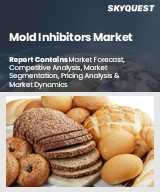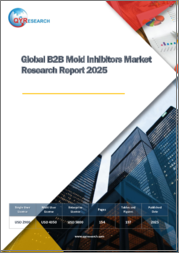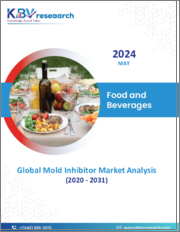
|
시장보고서
상품코드
1781674
세계의 클린 라벨 항곰팡이제 시장 조사 보고서(2025-2033년) : 산업 분석, 규모, 점유율, 성장, 동향, 예측Global Clean Label Mold Inhibitors Market Research Report- Industry Analysis, Size, Share, Growth, Trends and Forecast 2025 to 2033 |
||||||
세계의 클린 라벨 항곰팡이제 시장 규모는 2024년 12억 8,000만 달러에서 2033년에는 23억 3,000만 달러로 성장할 것으로 예측되며, 2026-2033년의 예측기간 동안 6.83%의 견조한 연평균 복합 성장률(CAGR)을 나타낼 전망입니다.
클린 라벨 항곰팡이제 시장은 천연 식품 및 가공도가 낮은 식품에 대한 소비자 수요가 높아짐에 따라 크게 성장할 전망입니다. 소비자의 건강 지향이 높아지고, 식품에 포함되는 성분에 대한 의식이 높아짐에 따라, 인지도가 높은 천연 성분을 포함한 클린 라벨 제품의 기호가 높아지고 있습니다. 항곰팡이제는 식품의 품질과 안전성을 유지하면서 유통기한을 연장하는 중요한 역할을 담당합니다. 클린 라벨 식품 동향 증가는 투명성과 건강에 대한 소비자의 기대에 따라 효과적인 항곰팡이제에 대한 수요를 더욱 밀어 올리고 있습니다.
배합과 원료 조달에서의 혁신도 클린 라벨 항곰팡이제 시장의 미래를 형성하고 있습니다. 각 제조업체는 에센셜 오일이나 추출물 등 식물 유래의 천연 항곰팡이제의 개발에 주력해 클린 라벨의 솔루션에 대한 수요 증가에 부응하고 있습니다. 또한, 보존 기술의 진보에 의해 식품의 관능 특성을 손상시키지 않는 효과적인 항곰팡이제의 개발이 가능해지고 있습니다. 시장이 발전함에 따라 클린 라벨 원칙의 통합과 함께 연구 개발을 선호하는 기업이 클린 라벨 항곰팡이제 시장에서 더 큰 점유율을 얻을 가능성이 높습니다.
게다가 지속 가능성과 환경 책임에 대한 관심 증가는 클린 라벨 항곰팡이제 시장에서 소비자의 선택에 영향을 미칩니다. 환경 문제에 대한 의식이 높아짐에 따라 소비자는 지속 가능한 조달과 생산 방법을 우선하는 등 자신의 가치관에 맞는 제품을 적극적으로 요구하고 있습니다. 환경에 미치는 영향을 최소화한 친환경 항곰팡이제의 개발은 환경 의식이 높은 소비자들에게 호소하여 지지를 모으고 있습니다. 클린 라벨 항곰팡이제 시장이 소비자의 기호의 변화나 규제 요건에 계속 적응하고 있는 가운데, 혁신, 지속 가능성, 품질을 우선하는 기업은 향후 수년간 지속적인 성장과 성공을 거둘 수 있을 것으로 보입니다.
본 보고서는 다양한 산업 및 시장에 대한 종합적이고 실용적인 인사이트를 고객에게 제공할 수 있도록 면밀히 작성되었습니다. 각 보고서에는 시장 상황을 완전히 이해하기 위한 몇 가지 중요한 요소가 포함되어 있습니다.
시장 개요 : 정의, 분류, 업계 현황에 대한 개요 등 시장에 대한 자세한 정보를 제공합니다.
시장 역학 : 시장 성장에 영향을 미치는 주요 촉진요인 및 억제요인, 기회, 과제를 상세하게 분석합니다. 이 섹션에서는 기술 발전, 규제 변경, 새로운 동향 등의 요인을 확인합니다.
세분화 분석 : 제품 유형, 용도, 최종 사용자, 지역 등의 기준에 따라 시장을 명확한 부문으로 나눕니다. 이 분석은 각 부문의 성과와 미래를 제시합니다.
경쟁 구도 : 시장 점유율, 제품 포트폴리오, 전략적 이니셔티브, 재무 실적 등 주요 시장 기업을 종합적으로 평가했습니다. 주요 기업이 채용하는 경쟁 역학과 주요 전략에 대한 인사이트를 제공합니다.
시장 예측 : 실제 데이터와 현재 시장 상황에 따라 일정 기간 동안 시장 규모와 성장 동향을 예측합니다. 여기에는 정량적 분석과 향후 시장 궤적을 보여주는 그래프 표시가 포함됩니다.
지역 분석 : 지역별 시장 성과를 평가하고 주요 시장과 지역 동향을 밝혀 지역 시장 역학과 비즈니스 기회에 대한 이해를 돕습니다.
새로운 동향과 기회 : 현재 시장 동향과 새로운 시장 동향, 기술 혁신, 잠재적인 투자 대상 분야를 파악합니다. 미래 시장 개척과 성장 전망에 대한 인사이트를 제공합니다.
목차
제1장 서문
제2장 주요 요약
- 시장의 하이라이트
- 세계 시장 현황
제3장 클린 라벨 항곰팡이제 업계의 분석
- 소개 : 시장 역학
- 시장 성장 촉진요인
- 시장 성장 억제요인
- 시장 기회
- 업계 동향
- Porter's Five Forces 분석
- 시장 매력 분석
제4장 밸류체인 분석
- 밸류체인 분석
- 원재료 분석
- 원재료 리스트
- 원재료 제조업체 리스트
- 주요 원재료의 가격 동향
- 잠재적 구매자 목록
- 마케팅 채널
- 직접 마케팅
- 간접 마케팅
- 마케팅 채널 발전 동향
제5장 세계의 클린 라벨 항곰팡이제 시장 분석 : 성분별
- 성분별 개요
- 성분별 실적 및 예측 데이터 분석
- 식초
- 전분
- 유청
- 발효 밀가루
- 기타
제6장 세계의 클린 라벨 항곰팡이제 시장 분석 : 최종 사용자별
- 최종 사용자별 개요
- 최종 사용자별 실적 및 예측 데이터 분석
- 식음료
- 의약품
- 동물 사료
- 퍼스널케어&화장품
- 기타
제7장 세계의 클린 라벨 항곰팡이제 시장 분석 : 지역별
- 지역별 전망
- 소개
- 북미의 매출 분석
- 개요, 분석 및 예측
- 북미 : 부문별
- 북미 : 국가별
- 미국
- 캐나다
- 멕시코
- 유럽의 매출 분석
- 개요, 분석 및 예측
- 유럽 : 부문별
- 유럽 : 국가별
- 영국
- 프랑스
- 독일
- 이탈리아
- 러시아
- 기타 유럽
- 아시아태평양의 매출 분석
- 개요, 분석 및 예측
- 아시아태평양 : 부문별
- 아시아태평양 : 국가별
- 중국
- 인도
- 일본
- 한국
- 호주
- 동남아시아
- 기타 아시아태평양
- 라틴아메리카의 매출 분석
- 개요, 분석 및 예측
- 라틴아메리카 : 부문별
- 라틴아메리카 : 국가별
- 브라질
- 아르헨티나
- 페루
- 칠레
- 기타 라틴아메리카
- 중동 및 아프리카의 매출 분석
- 개요, 분석 및 예측
- 중동 및 아프리카 : 부문별
- 중동 및 아프리카 : 국가별
- 사우디아라비아
- 아랍에미리트(UAE)
- 이스라엘
- 남아프리카
- 기타 중동 및 아프리카
제8장 클린 라벨 항곰팡이제 기업 경쟁 구도
- 클린 라벨 항곰팡이제 시장의 경쟁
- 제휴, 협력 및 합의
- 합병 및 인수
- 신제품 발매
- 기타 개발
제9장 기업 프로파일
- 주요 기업의 시장 점유율 분석
- 시장 집중도
- AB Enzymes
- Archer Daniels Midland Company
- Associated British Foods Plc
- BASF SE
- Cargill Incorporated
- Corbion NV
- DuPont De Nemours Inc.
- Handary SA
- Kemin Industries Inc.
- Koninklijke DSM NV
- Lesaffre Et Compagnie
- Puratos Group
- Shenzhen Leveking Bio-Engineering Co. Ltd.
- Tate & Lyle PLC
- The Scoular Company
Global Clean Label Mold Inhibitors Market size is anticipated to grow from USD 1.28 Billion in 2024 to USD 2.33 Billion by 2033, showcasing a robust Compound Annual Growth Rate (CAGR) of 6.83% during the forecast period of 2026 to 2033.
The Clean Label Mold Inhibitors Market is poised for significant growth, driven by the increasing consumer demand for natural and minimally processed food products. As consumers become more health-conscious and aware of the ingredients in their food, the preference for clean label products that contain recognizable and natural ingredients is on the rise. Mold inhibitors play a crucial role in extending the shelf life of food products while maintaining their quality and safety. The growing trend of clean label foods is further propelling the demand for effective mold inhibitors that align with consumer expectations for transparency and health.
Innovations in formulation and ingredient sourcing are also shaping the future of the clean label mold inhibitors market. Manufacturers are focusing on developing natural mold inhibitors derived from plant-based sources, such as essential oils and extracts, to meet the growing demand for clean label solutions. Additionally, advancements in preservation technologies are enabling the creation of effective mold inhibitors that do not compromise the sensory attributes of food products. As the market evolves, companies that prioritize research and development, along with the integration of clean label principles, will likely capture a larger share of the clean label mold inhibitors market.
Moreover, the increasing focus on sustainability and environmental responsibility is influencing consumer choices in the clean label mold inhibitors market. As awareness of environmental issues rises, consumers are actively seeking products that align with their values, including those that prioritize sustainable sourcing and production practices. The development of eco-friendly mold inhibitors that minimize environmental impact is gaining traction, appealing to environmentally conscious consumers. As the clean label mold inhibitors market continues to adapt to changing consumer preferences and regulatory requirements, companies that prioritize innovation, sustainability, and quality will be well-positioned for sustained growth and success in the coming years.
Our reports are meticulously crafted to provide clients with comprehensive and actionable insights into various industries and markets. Each report encompasses several critical components to ensure a thorough understanding of the market landscape:
Market Overview: A detailed introduction to the market, including definitions, classifications, and an overview of the industry's current state.
Market Dynamics: In-depth analysis of key drivers, restraints, opportunities, and challenges influencing market growth. This section examines factors such as technological advancements, regulatory changes, and emerging trends.
Segmentation Analysis: Breakdown of the market into distinct segments based on criteria like product type, application, end-user, and geography. This analysis highlights the performance and potential of each segment.
Competitive Landscape: Comprehensive assessment of major market players, including their market share, product portfolio, strategic initiatives, and financial performance. This section provides insights into the competitive dynamics and key strategies adopted by leading companies.
Market Forecast: Projections of market size and growth trends over a specified period, based on historical data and current market conditions. This includes quantitative analyses and graphical representations to illustrate future market trajectories.
Regional Analysis: Evaluation of market performance across different geographical regions, identifying key markets and regional trends. This helps in understanding regional market dynamics and opportunities.
Emerging Trends and Opportunities: Identification of current and emerging market trends, technological innovations, and potential areas for investment. This section offers insights into future market developments and growth prospects.
SEGMENTATION COVERED IN THE REPORT
By Ingredient
- Vinegar
- Starch
- Whey
- Fermented Flour
- Others
By End-User
- Food & Beverages
- Pharmaceuticals
- Animal Feed
- Personal Care & Cosmetics
- Others
- COMPANIES PROFILED
- AB Enzymes
- Archer Daniels Midland Company
- Associated British Foods plc
- BASF SE
- Cargill Incorporated
- Corbion NV
- DuPont de Nemours Inc.
- Handary SA
- Kemin Industries Inc.
- Koninklijke DSM N.V.
- Lesaffre et Compagnie
- Puratos Group
- Shenzhen Leveking Bio-Engineering Co. Ltd.
- Tate & Lyle PLC
- The Scoular Company.
- The above list can be customized.
TABLE OF CONTENTS
1. PREFACE
- 1.1. Report Description
- 1.1.1 Objective
- 1.1.2 Target Audience
- 1.1.3 Unique Selling Proposition (USP) & offerings
- 1.2. Research Scope
- 1.3. Research Methodology
- 1.3.1 Market Research Process
- 1.3.2 Market Research Methodology
2. EXECUTIVE SUMMARY
- 2.1. Highlights of Market
- 2.2. Global Market Snapshot
3. CLEAN LABEL MOLD INHIBITORS INDUSTRY ANALYSIS
- 3.1. Introduction - Market Dynamics
- 3.2. Market Drivers
- 3.3. Market Restraints
- 3.4. Opportunities
- 3.5. Industry Trends
- 3.6. Porter's Five Force Analysis
- 3.7. Market Attractiveness Analysis
- 3.7.1 Market Attractiveness Analysis By Ingredient
- 3.7.2 Market Attractiveness Analysis By End-User
- 3.7.3 Market Attractiveness Analysis By Regions
4. VALUE CHAIN ANALYSIS
- 4.1. Value Chain Analysis
- 4.2. Raw Material Analysis
- 4.2.1 List of Raw Materials
- 4.2.2 Raw Material Manufactures List
- 4.2.3 Price Trend of Key Raw Materials
- 4.3. List of Potential Buyers
- 4.4. Marketing Channel
- 4.4.1 Direct Marketing
- 4.4.2 Indirect Marketing
- 4.4.3 Marketing Channel Development Trend
5. GLOBAL CLEAN LABEL MOLD INHIBITORS MARKET ANALYSIS BY INGREDIENT
- 5.1. Overview By Ingredient
- 5.2. Historical and Forecast Data Analysis By Ingredient
- 5.3. Vinegar Historic and Forecast Sales By Regions
- 5.4. Starch Historic and Forecast Sales By Regions
- 5.5. Whey Historic and Forecast Sales By Regions
- 5.6. Fermented Flour Historic and Forecast Sales By Regions
- 5.7. Others Historic and Forecast Sales By Regions
6. GLOBAL CLEAN LABEL MOLD INHIBITORS MARKET ANALYSIS BY END-USER
- 6.1. Overview By End-User
- 6.2. Historical and Forecast Data Analysis By End-User
- 6.3. Food & Beverages Historic and Forecast Sales By Regions
- 6.4. Pharmaceuticals Historic and Forecast Sales By Regions
- 6.5. Animal Feed Historic and Forecast Sales By Regions
- 6.6. Personal Care & Cosmetics Historic and Forecast Sales By Regions
- 6.7. Others Historic and Forecast Sales By Regions
7. GLOBAL CLEAN LABEL MOLD INHIBITORS MARKET ANALYSIS BY GEOGRAPHY
- 7.1. Regional Outlook
- 7.2. Introduction
- 7.3. North America Sales Analysis
- 7.3.1 Overview, Historic and Forecast Data Sales Analysis
- 7.3.2 North America By Segment Sales Analysis
- 7.3.3 North America By Country Sales Analysis
- 7.3.4 United States Sales Analysis
- 7.3.5 Canada Sales Analysis
- 7.3.6 Mexico Sales Analysis
- 7.4. Europe Sales Analysis
- 7.4.1 Overview, Historic and Forecast Data Sales Analysis
- 7.4.2 Europe By Segment Sales Analysis
- 7.4.3 Europe By Country Sales Analysis
- 7.4.4 United Kingdom Sales Analysis
- 7.4.5 France Sales Analysis
- 7.4.6 Germany Sales Analysis
- 7.4.7 Italy Sales Analysis
- 7.4.8 Russia Sales Analysis
- 7.4.9 Rest Of Europe Sales Analysis
- 7.5. Asia Pacific Sales Analysis
- 7.5.1 Overview, Historic and Forecast Data Sales Analysis
- 7.5.2 Asia Pacific By Segment Sales Analysis
- 7.5.3 Asia Pacific By Country Sales Analysis
- 7.5.4 China Sales Analysis
- 7.5.5 India Sales Analysis
- 7.5.6 Japan Sales Analysis
- 7.5.7 South Korea Sales Analysis
- 7.5.8 Australia Sales Analysis
- 7.5.9 South East Asia Sales Analysis
- 7.5.10 Rest Of Asia Pacific Sales Analysis
- 7.6. Latin America Sales Analysis
- 7.6.1 Overview, Historic and Forecast Data Sales Analysis
- 7.6.2 Latin America By Segment Sales Analysis
- 7.6.3 Latin America By Country Sales Analysis
- 7.6.4 Brazil Sales Analysis
- 7.6.5 Argentina Sales Analysis
- 7.6.6 Peru Sales Analysis
- 7.6.7 Chile Sales Analysis
- 7.6.8 Rest of Latin America Sales Analysis
- 7.7. Middle East & Africa Sales Analysis
- 7.7.1 Overview, Historic and Forecast Data Sales Analysis
- 7.7.2 Middle East & Africa By Segment Sales Analysis
- 7.7.3 Middle East & Africa By Country Sales Analysis
- 7.7.4 Saudi Arabia Sales Analysis
- 7.7.5 UAE Sales Analysis
- 7.7.6 Israel Sales Analysis
- 7.7.7 South Africa Sales Analysis
- 7.7.8 Rest Of Middle East And Africa Sales Analysis
8. COMPETITIVE LANDSCAPE OF THE CLEAN LABEL MOLD INHIBITORS COMPANIES
- 8.1. Clean Label Mold Inhibitors Market Competition
- 8.2. Partnership/Collaboration/Agreement
- 8.3. Merger And Acquisitions
- 8.4. New Product Launch
- 8.5. Other Developments
9. COMPANY PROFILES OF CLEAN LABEL MOLD INHIBITORS INDUSTRY
- 9.1. Top Companies Market Share Analysis
- 9.2. Market Concentration Rate
- 9.3. AB Enzymes
- 9.3.1 Company Overview
- 9.3.2 Company Revenue
- 9.3.3 Products
- 9.3.4 Recent Developments
- 9.4. Archer Daniels Midland Company
- 9.4.1 Company Overview
- 9.4.2 Company Revenue
- 9.4.3 Products
- 9.4.4 Recent Developments
- 9.5. Associated British Foods Plc
- 9.5.1 Company Overview
- 9.5.2 Company Revenue
- 9.5.3 Products
- 9.5.4 Recent Developments
- 9.6. BASF SE
- 9.6.1 Company Overview
- 9.6.2 Company Revenue
- 9.6.3 Products
- 9.6.4 Recent Developments
- 9.7. Cargill Incorporated
- 9.7.1 Company Overview
- 9.7.2 Company Revenue
- 9.7.3 Products
- 9.7.4 Recent Developments
- 9.8. Corbion NV
- 9.8.1 Company Overview
- 9.8.2 Company Revenue
- 9.8.3 Products
- 9.8.4 Recent Developments
- 9.9. DuPont De Nemours Inc.
- 9.9.1 Company Overview
- 9.9.2 Company Revenue
- 9.9.3 Products
- 9.9.4 Recent Developments
- 9.10. Handary SA
- 9.10.1 Company Overview
- 9.10.2 Company Revenue
- 9.10.3 Products
- 9.10.4 Recent Developments
- 9.11. Kemin Industries Inc.
- 9.11.1 Company Overview
- 9.11.2 Company Revenue
- 9.11.3 Products
- 9.11.4 Recent Developments
- 9.12. Koninklijke DSM N.V.
- 9.12.1 Company Overview
- 9.12.2 Company Revenue
- 9.12.3 Products
- 9.12.4 Recent Developments
- 9.13. Lesaffre Et Compagnie
- 9.13.1 Company Overview
- 9.13.2 Company Revenue
- 9.13.3 Products
- 9.13.4 Recent Developments
- 9.14. Puratos Group
- 9.14.1 Company Overview
- 9.14.2 Company Revenue
- 9.14.3 Products
- 9.14.4 Recent Developments
- 9.15. Shenzhen Leveking Bio-Engineering Co. Ltd.
- 9.15.1 Company Overview
- 9.15.2 Company Revenue
- 9.15.3 Products
- 9.15.4 Recent Developments
- 9.16. Tate & Lyle PLC
- 9.16.1 Company Overview
- 9.16.2 Company Revenue
- 9.16.3 Products
- 9.16.4 Recent Developments
- 9.17. The Scoular Company
- 9.17.1 Company Overview
- 9.17.2 Company Revenue
- 9.17.3 Products
- 9.17.4 Recent Developments



















